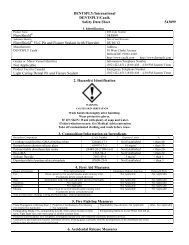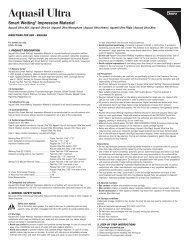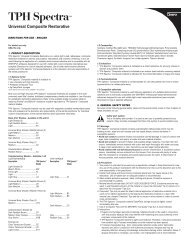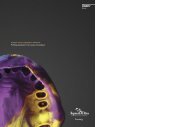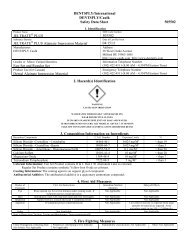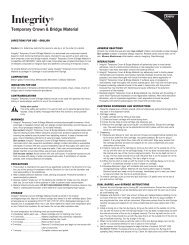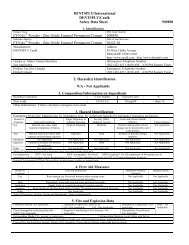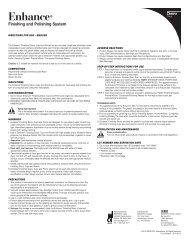SDS - Caulk
SDS - Caulk
SDS - Caulk
You also want an ePaper? Increase the reach of your titles
YUMPU automatically turns print PDFs into web optimized ePapers that Google loves.
Product Name<br />
CAULK ® 50% Tooth CONDITIONER LIQUID<br />
CAULK ® 34% Tooth CONDITIONER GEL<br />
Trade Name & Synonyms<br />
CAULK ® 50% Tooth CONDITIONER LIQUID<br />
CAULK ® 34% Tooth CONDITIONER GEL<br />
Manufacturer<br />
DENTSPLY/<strong>Caulk</strong><br />
Grades or Minor Variant Identities<br />
Bottles and Syringes<br />
Product Use (for Canada)<br />
Not Applicable<br />
DENTSPLY/International<br />
DENTSPLY/<strong>Caulk</strong><br />
Safety Data Sheet 546899<br />
1. Product and Company Identification<br />
M<strong>SDS</strong> Code Number<br />
546899<br />
Date of Last Revision<br />
11/11/10<br />
2. Hazard(s) Identification<br />
Address<br />
38 West Clarke Avenue<br />
Milford DE 19963-1805<br />
http://www.caulk.com, http://www.dentsply.com<br />
Information Telephone Number<br />
(302) 422-4511 (8:00 AM – 4:30 PM Eastern Time)<br />
Emergency Telephone Number<br />
(302) 422-4511 (8:00 AM – 4:30 PM Eastern Time)<br />
Do not breathe in dust or mist.<br />
Wash hands thoroughly after handling.<br />
Wear protective gloves.<br />
If SWALLOWED: Rinse mouth. Do NOT induce vomiting.<br />
IF ON SKIN: Remove immediately all contaminated clothing. Rinse skin with water.<br />
If INHALED: Remove victim to fresh air and keep at rest in a position comfortable for breathing.<br />
Immediately call a POISON Center or physician.<br />
IF IN EYES: Rinse cautiously with water for several minutes. Remove contact lenses, if present and easy to do so. Continue rinsing.<br />
Store locked up.<br />
Dispose of contents/container in accordance with local regulations.<br />
3. Composition of Ingredients – Tooth Conditioner Liquid<br />
Hazardous Components C.A.S. Number Exposure Limits %<br />
Phosphoric Acid 7664-38-2 1 mg/M 3 50<br />
3. Composition of Ingredients – Tooth Conditioner Gel<br />
Hazardous Components C.A.S. Number Exposure Limits %<br />
Phosphoric Acid 7664-38-2 1 mg/M 3 34<br />
Other Information: Blue colorant is a fluorescent organic dye.<br />
Routes of<br />
Exposure<br />
Eye<br />
Skin<br />
Danger<br />
Causes severe skin burns and eye damage<br />
First Aid Instructions<br />
4. First Aid Measures<br />
IF IN EYES: Rinse cautiously with water for several minutes. Remove<br />
contact lenses, if present and easy to do. Continue rinsing.<br />
If symptoms persist consult physician.<br />
IF ON SKIN: Remove/Take off immediately all contaminated clothing.<br />
Rinse skin with water/shower. Wash contaminated clothing before reuse.<br />
If symptoms persist consult physician.<br />
Immediate Medical<br />
Attention<br />
Not Applicable<br />
Not Applicable<br />
Delayed Effects<br />
Not Applicable<br />
Not Applicable<br />
Inhalation IF INHALED: Remove victim to fresh air and keep at a rest position Not Applicable Not Applicable
comfortable for breathing.<br />
Immediately call a poison center or if symptoms persist, consult physician.<br />
Ingestion IF SWALLOWED: Rinse mouth. Do NOT induce vomiting. Not Applicable Not Applicable<br />
If symptoms persist consult physician.<br />
Other Not Applicable Not Applicable Not Applicable<br />
Note to Physicians (Treating, Testing and Monitoring): Treat symptomatically.<br />
5. Fire and Explosion Data<br />
Flashpoint Method: Not Applicable Flammable (Explosive) Limits in Air<br />
Autoignition Temperature: Not Applicable Other: Not<br />
LEL: Not Established UEL: Not Established<br />
Applicable<br />
Flame Propagation or Burning Rate Properties Contributing to Fire Intensity: Not Applicable Flammability Classification: Not<br />
(for Solids): Not Applicable<br />
Applicable<br />
Extinguishing Media: Use extinguishing media suitable for surrounding area.<br />
Extinguishing Media to Avoid: Water with full jet.<br />
Protection and Procedures for Firefighters: Firefighters should wear self-contained respiratory protective devices.<br />
Unusual Fire and Explosion Hazards: Formation of toxic gases is possible during heating or in case of fire.<br />
6. Accidental Release Measures<br />
Containment Techniques: For Liquid: Absorb with liquid binding material (sand, vermiculite, diatomite, acid binders, universal binders or sawdust). For Gel,<br />
since material is a paste, scoop up bulk material and place in a suitable waste container.<br />
Spill/Leak Clean-up Procedures and Equipment: Absorb with liquid binding material (sand, vermiculite, diatomite, acid binders, universal binders or sawdust).<br />
Scoop up bulk material and place in a suitable waste container.<br />
Evacuation Procedures: Not Applicable Special Instructions: Not Applicable Reporting Requirements: Not Applicable<br />
7. Handling and Storage<br />
Handling Practices and Warnings: Product is intended for dental use only. Handling of this product should be by trained dental healthcare professionals only.<br />
Observe normal care for working with chemicals.<br />
Storage Practices and Warnings: Store only in the original package. Keep package tightly sealed. Store in a dry area. Store away from food and beverages.<br />
8. Exposure Control / Personal Protection<br />
Ventilation: None required during normal intended use of this product<br />
Other Engineering Controls: Not Applicable<br />
Routes of Entry Personal Protective Equipment (PPE) for Normal Use PPE for Emergencies<br />
Eye/Face Safety Glasses Not Applicable<br />
Skin The glove material has to be impermeable and resistant to the product. Not Applicable<br />
Inhalation Not required for normal volumes used in Dental office. Not Applicable<br />
Body Protection Protective work clothing Not Applicable<br />
General Hygiene Considerations and Work Practices: Keep away from foodstuffs, beverages and feed. Immediately remove all soiled and contaminated clothing.<br />
Wash hands before breaks and at end of work. Avoid contact with the eyes and skin.<br />
Protective Measures During Repair and Maintenance of Contaminated Equipment: Not Applicable<br />
Other Protective Measures and Equipment: Not Applicable<br />
9. Physical and Chemical Characteristics<br />
Appearance: Liquid is clear. Gel is blue colored paste.<br />
Odor: Acrid.<br />
Normal Physical State: Liquid, Gel is a paste.<br />
Melting Point: Not Applicable<br />
Specific Gravity: 1.3 g/cm 3 Solubility in Water: Not Soluble pH: < 2<br />
Vapor Pressure (mm Hg): Not Established Vapor Density (AIR=1): Not Applicable Evaporation Rate (Butyl Acetate =1) Not Applicable<br />
10. Stability and Reactivity Data<br />
Incompatibility (Materials to Avoid): Not Applicable<br />
Hazardous Products Produced During Decomposition: Not Applicable.<br />
Hazardous Polymerization: May Occur May Not Occur Conditions to Avoid: High Temperatures, ignition sources.<br />
Stability? Stable Unstable Conditions to Avoid: High Temperatures, ignition sources.<br />
11. Toxicological Information<br />
Toxicity Data, Epidemiology Studies, Carcinogenicity, Neurological Effects, Genetic Effects, Reproductive Effects, or Structure Activity Data:<br />
Material is a corrosive acid and as such is irritating to skin and mucous membranes.<br />
Emergency Overview: Material is corrosive.<br />
Routes of<br />
Exposure<br />
Signs and Symptoms<br />
Single, Repeated, or<br />
Lifetime Exposure<br />
Severity (Mild,<br />
Moderate, Severe)<br />
Acute and Chronic Health Effect(s)<br />
Target<br />
Organ(s)
Eye<br />
Skin<br />
Material is corrosive and<br />
may cause irritation.<br />
Material is corrosive and<br />
may cause irritation.<br />
Single & Repeated Severe Irritation and possible corneal damage due<br />
to the corrosive nature of product.<br />
Single & Repeated Moderate to severe Irritation due to the corrosive nature of the<br />
depending on<br />
product.<br />
contact time.<br />
Not Applicable<br />
Not Applicable<br />
Inhalation Not Applicable Not Applicable Not Applicable Not Applicable Not Applicable<br />
Ingestion Material is corrosive and Not Applicable Moderate Irritation due to the corrosive nature of the Not Applicable<br />
may cause irritation.<br />
product.<br />
Other Not Applicable Not Applicable Not Applicable Not Applicable Not Applicable<br />
Medical Conditions Aggravated by Exposure: Open sores and wounds of the skin.<br />
Carcinogenicity NTP?: Not listed IARC monographs?: Not listed OSHA regulated?: No All components of this product are in<br />
compliance with the inventory listing Requirements of the U. S. Toxic Substances Control Act (TSCA) Chemical Substance Inventory.<br />
Potential Environmental Effects Do not allow to enter sewers/ surface or ground water.<br />
NFPA Hazard Classification Ratings (Scale 0-4), Health = 3, Fire = 0, Reactivity = 0 Specific Hazard = Corrosive / Acid<br />
12. Ecological Information<br />
Toxicity Data, Environmental Fate, Physical/Chemical Data, or other Data Supporting Environmental Hazard Statements: Water Hazard class1 (Self-assessment):<br />
slightly hazardous for water. Do not allow undiluted product or large quantities of it to reach ground water, water streams or sewage system. Toxic to fish. Also<br />
poisonous for fish and plankton in water bodies. Toxic for aquatic organisms.<br />
13. Disposal Considerations<br />
Regulations: Must not be disposed of together with household garbage. Do not allow product to reach sewage system.<br />
Dispose of material as solid waste in a closed container. Dispose of in accordance with Federal, State and Local regulations<br />
Properties (Physical/Chemical) Affecting Disposal: Dispose of material as solid waste in a closed container.<br />
14. Transport Information<br />
Regulated for Shipping: Yes DOT Shipping Name: Corrosive Liquid, n.o.s. (contains Phosphoric Acid) Packing Group: II<br />
Do Changes in Quantities, packaging, or shipment method change product<br />
classification? Yes<br />
Hazard Class: 8 UN Identification Number: 1760<br />
15. Regulatory Information<br />
This product has been classified in accordance with the hazard criteria of the Globally Harmonized System of Classification and<br />
Labeling of Chemicals and the <strong>SDS</strong> contains all of the information required by the Canadian Controlled Products Regulations.<br />
U.S. Federal Regulations: CERCLA 103 Reportable Quantity: CAS# 7664-38-2 Phosphoric Acid 5000 pounds (2268Kg) Many states have more stringent release<br />
reporting requirements. Report spills required under federal, state and local regulations<br />
Section 313 Toxic Chemicals: This product contains the following chemicals subject to Annual Release Reporting Requirements Under SARA Title III, Section<br />
313 (40 CFR 372): None<br />
Section 302 Extremely Hazardous Substances (TPQ): None<br />
EPA Toxic Substances Control Act (TSCA) Status: All of the components of this product are listed on the TSCA inventory.<br />
U.S. State Regulations California Proposition 65: This product does not contain any chemicals, which are on the California Proposition 65 list.<br />
Canada WHMIS, Workplace Hazardous Materials Information System: This product is not a controlled product.<br />
International Regulations: Canadian Environmental Protection Act: This product is a medical device and not subject to chemical notification requirements.<br />
European Community Labeling: Not a dangerous preparation. These R and S phrases apply to base and catalyst: R36/38 Irritating to eyes and skin. R51/53 Toxic<br />
to aquatic organisms, may cause long-term effects in the environment. S26 Incase of contact with eyes, rinse immediately with plenty of water and seek medical<br />
advice. S28 After contact with skin, wash immediately with plenty of water. S37 Wear suitable gloves. S57 Use appropriate container to avoid environmental<br />
contamination. S60 This material and its container must be disposed of as hazardous waste. These R and S phrases apply to catalyst: R41 Risk of serious damage<br />
to eyes. R50/53 Very toxic to aquatic organisms, may cause long-term effects in the environment. S24 Avoid contact with skin.<br />
European Inventory of New and Existing Chemicals Substances (EINECS): This product is a medical device and not subject to chemical notification<br />
requirements. Phosphoric Acid is known as EINECS #: 231-633-2 and CAS# 7664-38-2.<br />
Other: Not Applicable.<br />
16. Other Information<br />
To the best of our knowledge this product does not contain gluten, wheat grains, flaxseed, natural rubber, or natural latex.<br />
All components are synthetically produced; none are derived from animal products.<br />
This information is based on our present knowledge. However, this shall not constitute a guarantee for any specific products features and shall not establish a<br />
legally valid contractual relationship.<br />
The attached safety data sheet covers the dangers and measures to be taken when large quantities of material are released, for example due to accidents during<br />
transport or storage by the dealer. For quantities of material typically used in clinical practice, information necessary for safe use and storage of the product is<br />
given in the DFU.



